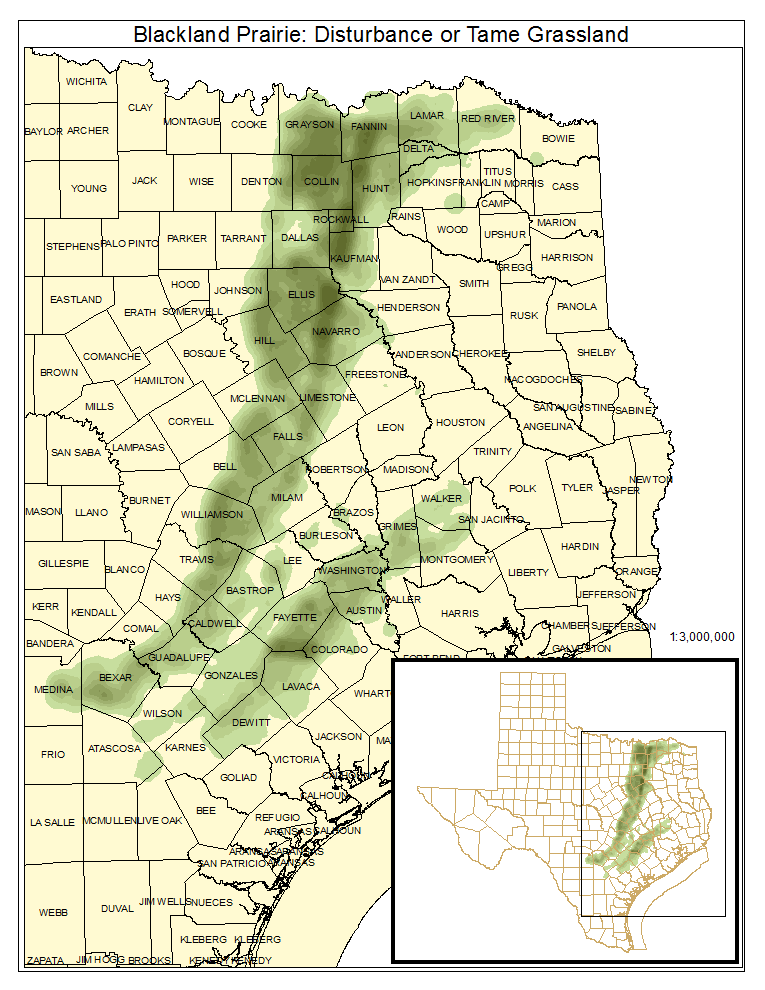Texas Blackland Tallgrass Prairie
Geology
Cretaceous shales, marls and limestones, such as those of the Pecan Gap Chalk, Marlbrook Marl, Eagle Ford, Gober Chalk, and Austin Chalk Formations, and Taylor, and Navarro Groups, as well as portions of the Eocene Midway Group and Wilcox formation. Also, Miocene formations (Fleming and Oakville Sandstone formations) underlie the southern outlier of Blackland prairie recognized as the Fayette Prairie.
Landform
Flat to gently rolling and dissected by drainages, with the most significant ridges associated with harder chalk formations.
Soils
Typically Vertisols, but this system may occupy Mollisols or Alfisols in limited parts of its distribution. The system generally occurs on calcareous clays, but may also occur on loams, clay loams, or even sandy clay loams.
Parent Description
Currently, only remnants of this system exist, with most of the historical distribution replaced by crop production or improved pasture. Schizachyrium scoparium (little bluestem) is the most ubiquitous component of occurrences of this system. Andropogon gerardii (big bluestem) and Sorghastrum nutans (Indiangrass) are also common dominants. Other species commonly encountered include Bouteloua curtipendula (sideoats grama), Carex microdonta (littletooth sedge), Sporobolus compositus (tall dropseed), Nassella leucotricha (Texas wintergrass), Bothriochloa laguroides ssp. torreyana (silver bluestem), Eriochloa sericea (Texas cupgrass), Paspalum floridanum (Florida paspalum), and Tridens strictus (longspike tridens). Forbs commonly encountered in this system include Symphyotrichum ericoides (heath aster), Stenaria nigricans var. nigricans (prairie bluets), Helianthus maximiliani (Maximilian sunflower), Rudbeckia hirta (blackeyed Susan), Bifora americana (prairie bishop), Acacia angustissima var. hirta (prairie acacia), Desmanthus illinoensis (Illinois bundleflower), and many more. Perhaps more commonly encountered species include Croton monanthogynus (doveweed), Amphiachyris dracunculoides (annual broomweed), and Asclepias spp. (milkweeds). Lowland sites and swales are often dominated by Tripsacum dactyloides (eastern gamagrass) and Panicum virgatum (switchgrass).
Ecological Mapping Systems
Blackland Prairie: Disturbance or Tame Grassland
Very little intact Blackland prairie remains within the region, so grasslands that are mapped in the region are assumed to primarily consist of disturbance or tame grasslands. Non-native grasses such as Cynodon dactylon (bermudagrass), Panicum coloratum (kleingrass), Bothriochloa ischaemum var. songarica (King Ranch bluestem) and Sorghum halepense (Johnsongrass) are frequently encountered. Weedy forbs such as Ambrosia psilostachya (western ragweed) and Amphiachyris dracunculoides (common broomweed) are often present. Prosopis glandulosa (honey mesquite) or Acacia farnesiana (huisache) are often present and may be fairly dense. Important native grasses may include Schizachyrium scoparium (little bluestem), Bothriochloa laguroides ssp. torreyana (silver bluestem), Sorghastrum nutans (Indiangrass), Nassella leucotricha (Texas wintergrass), Bouteloua hirsuta (hairy grama), and Aristida spp. (threeawn species).
Distribution Map

Photos

Public Land Occurrence
- Caddo National Grasslands Wildlife Management Area: Texas Parks & Wildlife Department
- Clymer Meadow Preserve: The Nature Conservancy
- Cooper Wildlife Management Area: Texas Parks & Wildlife Department
- Granger Wildlife Management Area: Texas Parks & Wildlife Department
- Hagerman National Wildlife Refuge: US Fish and Wildlife Service
- Jim Chapman Lake/Cooper Dam: US Army Corps of Engineers
- Lake Tawakoni State Park: Texas Parks & Wildlife Department